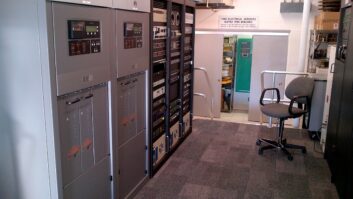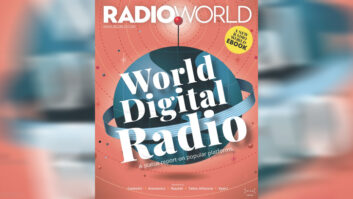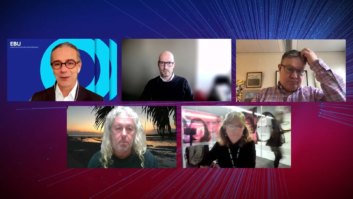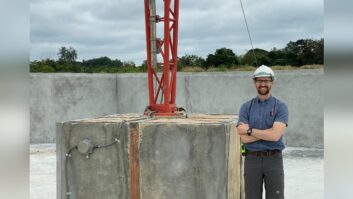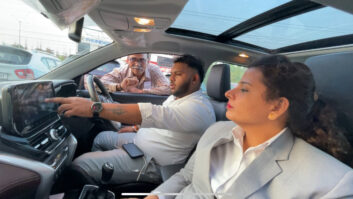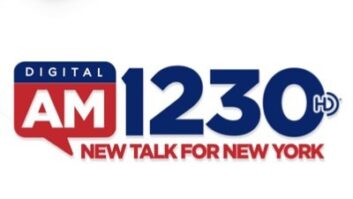The author is Director, Broadcast Business Development at Xperi Corp.
More than 2,600 radio stations in the United States, Canada and Mexico have already upgraded to HD Radio technology, creating some 4,400-plus individual channels of digital broadcast content by adding HD2, HD3 and HD4 programming.
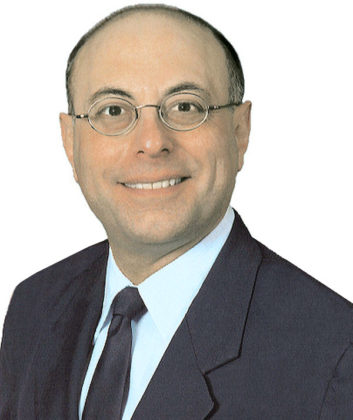
In fact, 79 percent of all radio listening in the United States is to stations that have already upgraded to the HD Radio digital standard. Almost 90 percent of the U.S. population lives within the signal coverage of a digital radio station. Forty auto manufacturers offer more than 275 vehicle models with HD Radio receivers, with over 62 percent of those models offering digital receivers as standard equipment.
Today, there are more than 55 million HD Radio-equipped cars on the road in North America, with another sold every three seconds, and well over half of all new cars sold in 2018 had an HD Radio receiver. Several U.S. markets are at 33 percent on-road HD Radio penetration, meaning one in three cars are fitted with HD Radio. Nationwide, almost 19 percent of all the cars in America have HD Radio receivers. Add in consumer home and portable radios and the total jumps to almost 59 million HD Radio receivers in North America.
THE CURRENT LANDSCAPE
U.S. radio broadcasters have long been utilizing HD Radio’s multicasting capability to serve diverse audiences it had never been cost-effective to reach prior to the advent of multicasting. Stations have leased channels to local churches and foreign-language broadcasters, providing these groups with, in effect, their own radio station at a tiny fraction of the cost of obtaining and building out a radio station, even if their market had an open frequency (which many U.S. markets do not).
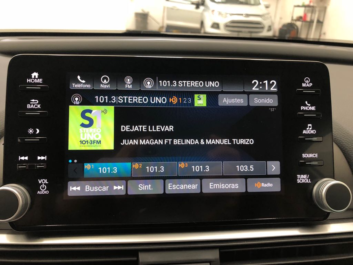
Imagine an HD2 channel programmed exclusively in Russian, or Korean, or Vietnamese or Thai. How about a local church providing 24/7 programming in Spanish? The leasee pays a flat fee to the radio station for use of that channel and sells advertising to local businesses catering to that community. This is a win-win for all concerned; the station gets easy, guaranteed revenue with essentially no effort on their part. The foreign-language group gets their own radio outlet, which they can monetize and make a profit on. And that community gets to hear music and talk programming from a radio outlet that (literally) “speaks their language.” It’s the ultimate community service — one that doesn’t require the broadcaster to sacrifice anything.
In Canada, a station has carried this concept even further. Canadian Multicultural Radio has created four distinct dedicated channels catering to speakers of various South Asian languages. It is the premier multiethnic, multicultural radio service in Toronto, with an estimated reach of well over 1 million listeners in the Greater Toronto area.
The station primarily targets South Asian communities, though caters to other regions as well. Their main (HD1) channel carries programs in Bengali, Creole, Gujarati, Hindi, Kannada, Konkani, Macedonian, Malayalam, Marathi, Nepali, Punjabi, Sinhalese, Somali, Tamil, Tagalog, Telugu, Tibetan, Twi and Urdu regularly.
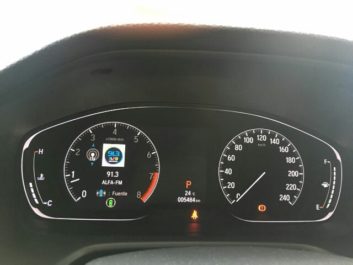
Their HD2 channel broadcasts in Tamil, their HD3 channel in Hindi/Urdu and the HD4 in Punjabi. All this targeted programming attracts local advertisers whose customers speak that particular language. From insurance to automobile dealers, from furniture stores to banking services, the ability for advertisers to speak to their clients and prospective clients in their native tongue is a powerful selling point for the station. It supports the establishment of four separate profit centers from four distinct communities from one radio frequency.
It also doesn’t hurt that there are already 2.6 million HD Radio-equipped cars on the road in Canada. Currently, there are 33 manufacturers in Canada offering HD Radio technology in some or all of their models. Over one car in three sold in Canada in 2018 came with an HD Radio receiver.
In Mexico, many stations are simulcasting their AM station on an HD2 multicast channel, providing an FM outlet for the AM programming at a time when AM is more and more difficult to receive in major urban areas due to interference and noise issues. HD Radio technology becomes the vehicle by which AM stations can transition their listeners over to FM without running the risk of losing any existing audience in the process.
In fact, Mexico just recently passed the 100 digital station mark, with 100 HD Radio broadcasts comprising 161 separate channels currently on-air in 34 markets spread across 21 states. Mexico officially approved HD Radio technology in June of 2011, and just three years later there were already 65 stations on the air. The 51 million listeners within coverage of an HD Radio station represent over 41 percent of the Mexican population.
HD RADIO’S SUCCESS
In North America the decision was taken to not “orphan” three quarters of a billion existing radios and cause 18,000 AM and FM radio stations to have to start over to reach their existing audiences. From the beginning, commercial broadcasting has co-existed with the public broadcasting sector in all three major North American nations. Moving to a new frequency band as was done in Europe would have created an undue financial hardship for broadcasters and a difficult and costly transition for consumers.
[Read: This Resource Resizes, Reformats Your Logo for HD Radio]
By using the IBOC [in-band, on-channel] hybrid approach in North America utilizing legacy MW and FM frequencies, today’s analog radios continue to receive the main program channel of their favorite station. The additional digital channels, images and metadata and audio quality improvements can only be obtained when the listener upgrades to a digital receiver, however.
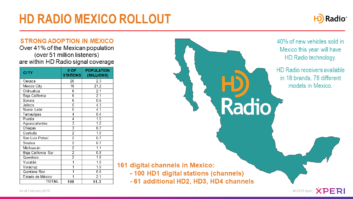
HD Radio technology delivers new services that benefit consumers and broadcasters alike. A great example is the Artist and Advertiser Experience feature. This is the technology’s ability to send a static image with an audio source, like album art or a station or advertiser logo. This allows broadcast radio to have the same “look and feel” as satellite radio or the streaming service the consumer may already be listening to in their car. Expect to see this feature on more and more car radios as the 2018 U.S. mandate for backup cameras in all new cars causes additional manufacturers to add this capability going forward. With all new vehicles already coming with a screen in the dashboard, the barrier to adding this additional visual feature has been lowered significantly.
